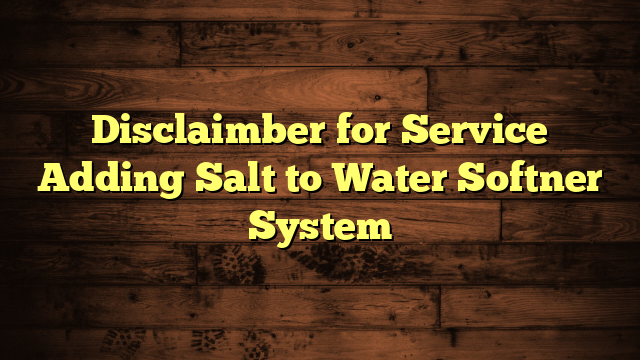How to Tell if Your Water Softner Is Working
You might not realize that even a small decline in your water softener's efficiency can lead to noticeable issues in your home. If you're starting to see soap scum on your shower walls or experiencing less lather from your soap, it's time to evaluate your system's performance. Checking for hard water stains on your fixtures can be an essential part of this assessment. But how do you identify the more subtle signs of a malfunction? Understanding these indicators can help you maintain ideal water quality and prolong the life of your appliances.
Key Takeaways
- Check for soap lathering; minimal lathering indicates hard water, while rich lather suggests proper softening.
- Inspect for hard water stains; presence of chalky deposits on fixtures indicates potential softener inefficiency.
- Monitor appliance performance; cloudy dishes from the dishwasher or stiff laundry may signal hard water issues.
- Regularly check salt levels in the brine tank; proper coverage is essential for effective softening.
- Schedule annual professional inspections to ensure the water softener is functioning optimally.
Signs of Hard Water
When you notice a film on your dishes or a chalky residue around your faucets, it's a clear sign that hard water is affecting your home. Hard water contains high levels of minerals, primarily calcium and magnesium, which can lead to several issues.
You might find that soap doesn't lather well, leaving your skin feeling dry and your hair dull after washing. This is one of the common hard water effects that can impact daily routines.
Additionally, you may experience mineral buildup in your appliances, like your dishwasher or coffee maker, reducing their efficiency and lifespan. Your laundry might feel stiff and look dingy, as hard water can hinder the effectiveness of detergents.
Fortunately, there are hard water solutions available. Installing a water softener is one of the most effective ways to combat these issues, as it can remove the excess minerals from your water supply.
Regularly descaling your appliances and using specific cleaning products designed for hard water can also help mitigate the effects. By recognizing these signs of hard water, you can take action to protect your home and guarantee a better quality of life.
Visual Tests for Soft Water
To quickly assess if your water softener is doing its job, you can perform a few simple visual tests.
These tests focus on identifying key visual indicators that suggest whether you have soft water or not. Here's what to look for:
- Soap Scum: Check your sinks, bathtubs, and shower walls. If you notice a buildup of soap scum, it could indicate hard water, meaning your softener mightn't be working effectively.
- Spotting on Dishes: After washing, inspect your dishes and glassware. If you see cloudy spots or mineral deposits, this may point to hard water issues and suggest that the softener is failing.
- Clogged Faucets and Showerheads: Look for mineral buildup on your faucets and showerheads. If you see white or chalky deposits, it's a clear sign that hard water is still present, indicating your softener may not be functioning properly.
Soap Lathering Test
To see if your water softener is doing its job, try the soap lathering test.
First, notice how soap behaves in hard water; it often struggles to create a good lather.
Then, compare that with how soap performs in softened water, where you should see a noticeable difference in foam and effectiveness.
Lathering With Hard Water
A simple and effective way to check if your water softener is doing its job is by performing a soap lathering test. Hard water effects can lead to significant lathering problems, making it essential to assess how your soap interacts with your water.
Here's how to perform the test:
- Fill a container with about a cup of hard water.
- Add a few drops of liquid soap and shake it vigorously for about 30 seconds.
- Observe the results: if you see minimal lather or suds, your water is likely still hard.
If your water softener is functioning properly, you should notice a rich lather forming easily. If you struggle to create bubbles, it's a sign your water softener may not be effectively removing the hardness minerals.
These lathering problems not only affect your cleaning routine but can also contribute to soap scum buildup on your fixtures and laundry. By conducting this simple test, you'll gain insight into your water quality and the performance of your softener, ensuring you maintain a more efficient and enjoyable home environment.
Comparing Softened Water
After checking your water's lathering ability, the next step is comparing softened water to hard water with respect to soap performance. This simple test can reveal a lot about your water quality.
Grab two clear containers and fill one with softened water and the other with hard water. Add the same amount of soap to each container and shake them gently.
Observe how well the soap lathers. You'll likely notice that softened water produces a richer, more stable lather. This difference is due to the absence of hard minerals like calcium and magnesium, which can inhibit soap performance. One of the key softened water benefits is its ability to create lather easily, which not only enhances cleaning but also reduces soap usage.
In your water quality comparison, pay attention to how long the lather lasts. Softened water should have a lasting lather, while hard water will quickly dissipate.
This test not only demonstrates the effectiveness of your water softener but also shows how much better softened water can be for your household tasks. Ultimately, it's a straightforward method to evaluate the performance of your water softener.
Observing Soap Performance
Testing soap performance through a lathering test is a straightforward way to see how well your water softener is functioning.
To evaluate soap effectiveness, you'll want to look closely at the lather quality when using your soap. Here's how you can perform the test:
- Gather supplies: Get a few different types of soap, such as liquid soap, bar soap, or dish soap.
- Run the test: Fill a clean container with softened water and add a small amount of soap. Agitate the water to create lather.
- Observe the results: Note how much lather forms and how long it lasts.
If you notice a rich, stable lather that forms quickly, your water softener is likely doing its job. Conversely, if you struggle to create lather or it dissipates rapidly, it may indicate hard water issues, affecting soap effectiveness.
Inconsistent lather quality can lead to frustration during washing and cleaning tasks.
Keeping an eye on these factors will help guarantee your water softener is functioning efficiently and providing you with the best results in your daily routines.
Water Taste and Odor
Water taste and odor can reveal a lot about your water softener's performance. If you've noticed any unusual smells or taste differences in your water, it might indicate that your softener isn't working correctly.
Ideally, softened water should have a clean, fresh taste. If your water tastes salty, it could mean the resin beads in your softener are breaking down. This can affect the overall water quality and make your drinking experience less enjoyable.
On the other hand, if your water has a metallic or musty odor, it might suggest other issues, such as bacterial growth or contamination. These problems can arise if your softener isn't regenerating properly, leading to stagnant water.
You should also pay attention to changes after you've recently added salt to the system; it can affect taste and odor temporarily but shouldn't linger.
Regularly sampling your water and being attentive to these sensory cues is crucial for maintaining ideal water quality. If you notice persistent issues, it's time to troubleshoot your softener or contact a professional for assistance.
Inspecting Appliances and Fixtures
To guarantee your water softener's working effectively, start by inspecting your appliances and fixtures.
You should monitor how well soap lathers; if it's not foaming up like it used to, that's a red flag.
Furthermore, check for any hard water stains and pay attention to how your appliances are performing—these signs can indicate whether your softener needs a little TLC.
Monitor Soap Lathering Ability
A simple way to gauge your water softener's effectiveness is by monitoring how well soap lathers in your appliances and fixtures.
If you notice that your soap isn't lathering like it used to, it could indicate that your water softener isn't doing its job. High soap effectiveness relies on soft water, which enhances lather quality.
Here's what to look for:
- Consistent Lather: When using soap, it should create a rich and stable lather. If it dissipates quickly or feels slimy, it's a sign of hard water interfering with soap effectiveness.
- Less Soap Usage: You should notice that you need less soap to achieve the same level of cleanliness. If you're pouring more than usual, it may mean your water isn't soft enough.
- No Residue: After rinsing, your fixtures and appliances should feel clean and not have any soap residue left behind. A soapy film can indicate hard water issues.
Check for Hard Water Stains
Regularly checking for hard water stains on your appliances and fixtures is vital in evaluating your water softener's performance. These stains are often chalky, white deposits that accumulate on surfaces like faucets, showerheads, and glassware. If you notice these unsightly marks, it could indicate that your water softener isn't working effectively.
To assess the situation, inspect areas that frequently come into contact with water. Pay attention to your sink, tub, and any kitchen appliances that use water, such as dishwashers and coffee makers. If you see hard water stains forming, it's time to take action. You may need to contemplate maintenance or even replacement of your water softener.
Stain prevention is important. Regular maintenance of your softener, such as checking salt levels and cleaning filters, can help reduce the occurrence of these stains.
You might also think about using vinegar or a specialized cleaner to remove existing stains while preventing future buildup. By staying vigilant and proactive, you can guarantee your water softener is doing its job, keeping your home and fixtures looking their best.
Inspect Appliance Performance Issues
When evaluating your water softener's effectiveness, don't overlook the performance of your appliances and fixtures.
If your water quality is suffering, it can impact appliance efficiency, leading to costly repairs or replacements.
Here are three key areas to inspect:
- Dishwasher Performance: Check for spots on your dishes. If they're still coming out cloudy or stained, your water softener may not be functioning properly.
- Clogged Pipes: Hard water deposits can accumulate in your plumbing. If you notice slow drainage or reduced water pressure, it could be a sign of mineral buildup.
- Washing Machine Issues: If your clothes feel stiff or look dingy, it may indicate that hard water is affecting your washing machine's ability to clean effectively.
Checking Salt Levels
Monitoring salt levels in your water softener is essential for ensuring it operates effectively. If the salt levels are too low, your system won't soften water properly, leading to hard water issues in your home.
Start by checking the salt measurement in the brine tank. Ideally, you should see salt covering the bottom, typically filling it up to about two-thirds of the tank.
While inspecting, keep an eye out for a salt bridge, which is a crusty layer that can form in the tank. This bridge prevents the salt from dissolving in the water, disrupting the softening process. If you notice a salt bridge, break it apart gently with a broom handle or similar tool.
In addition to checking the physical salt levels, you should also consider how often you refill the salt. If you're refilling monthly or more frequently, you might need to evaluate your system's capacity or usage.
Regularly monitoring and maintaining the right salt levels can keep your water softener running smoothly and help you avoid potential hard water problems.
Monitoring Water Pressure
After confirming your salt levels are adequate, it's important to keep an eye on your water pressure as well. Proper water flow is essential for your water softener to function effectively. A sudden drop in pressure could indicate issues that need addressing. By monitoring the pressure gauge regularly, you can detect problems early on.
Here are three key signs to watch for:
- Low Pressure: If you notice a significant decrease in water flow, it may mean your system is clogged or there's a malfunction.
- Fluctuating Pressure: Consistent pressure changes can signal that your softener isn't operating smoothly, potentially leading to ineffective softening.
- High Pressure: Excessively high pressure can strain your system and lead to leaks or bursts, impacting both your softener and plumbing.
Pay attention to these signs, and don't hesitate to investigate if something seems off.
Regularly checking your water pressure not only keeps your softener working efficiently but also helps maintain the overall health of your plumbing system.
Scheduling Professional Maintenance
To keep your water softener running at its best, scheduling professional maintenance is vital. Regular maintenance not only helps to guarantee your system is functioning properly, but it also extends its lifespan. Generally, you should aim for professional inspections at least once a year, but depending on your water quality and usage, you might need to adjust this maintenance frequency.
During these inspections, professionals can check for any issues, such as salt levels, resin beads, and overall efficiency. They'll also clean important components and test your water to confirm it's softening effectively. If you notice any signs of malfunction, like scale buildup or decreased water flow, don't wait for your scheduled maintenance; call in a professional sooner.
Keeping track of these maintenance schedules is essential for maximum performance. You might even consider setting reminders on your phone or calendar to guarantee you stay on top of it.
Frequently Asked Questions
How Often Should I Test My Water Hardness?
You should test your water hardness regularly to guarantee ideal water quality. Generally, testing every three to six months is recommended, but if you notice changes in water quality, increase the testing frequency.
Can Water Softeners Remove Chlorine From Water?
You might wonder if your water softener can tackle chlorine. Surprisingly, most aren't designed for chlorine removal. For ideal water quality, consider a separate filtration system specifically for effectively eliminating chlorine from your water supply.
What Is the Lifespan of a Water Softener?
A water softener typically lasts 10 to 15 years. For ideal water softener maintenance, watch for signs replacement's needed, like reduced efficiency or increased mineral buildup, which indicate it's time for a new unit.
Are There Any Health Risks to Softened Water?
Softened water's health effects can vary. While it's generally safe for most people, those on low-sodium diets should monitor sodium levels. Always consult a healthcare professional if you have concerns about softened water's impact on your health.
How Do I Choose the Right Salt for My Water Softener?
Choosing the right salt for your water softener depends on the type you have. Consider options like potassium chloride or salt alternatives if you prefer eco-friendly solutions. Always check manufacturer guidelines for the best results.
Conclusion
In summary, keeping an eye on your water softener's performance is essential for maintaining a comfortable home. Did you know that nearly 85% of U.S. households have hard water? By regularly checking for signs of hard water, inspecting your fixtures, and monitoring salt levels, you can guarantee your system is running smoothly. Don't hesitate to schedule professional maintenance if you notice any issues. Staying proactive will help you enjoy the benefits of soft water for years to come.







